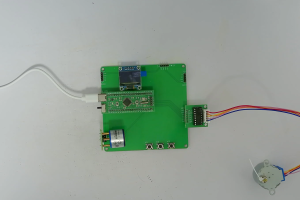设计说明书
总字数:12000+
摘要
随着汽车的普及,车内安全问题日益受到关注,其中车内低氧导致的窒息风险对人员安全构成严重威胁。传统的车内氧气监测依赖人工感知,存在反应滞后、判断不准确等问题,难以有效预防低氧窒息事故的发生。
基于 STM32F103C8T6 单片机的汽车内低氧防窒息保护装置,整合了氧气模块、步进电机、三个独立按键等,实现了车内氧气浓度的自动化监测与智能防护。系统核心功能包括:通过氧气模块实时监测车内氧气浓度;当氧气浓度低于设置的最小值时,自动控制步进电机转动,实现开窗通风;支持通过三个独立按键进行操作,按键 K1 用于增加氧气浓度阈值,每次增加 1 单位,按键 K2 用于降低氧气浓度阈值,每次减少 1 单位,按键 K3 用于手动控制窗户的开关。
该装置的实现,有效提升了车内低氧防护的自动化水平,减少了人工干预,确保在氧气浓度过低时能及时采取防护措施,为车内人员提供了安全保障,同时为同类汽车安全防护设备的研发提供了参考,具有较高的实际应用价值。
关键词:STM32F103C8T6;汽车内环境;低氧防护;氧气监测;步进电机;单片机
ABSTRACT
With the popularization of automobiles, in-vehicle safety issues have attracted increasing attention, among which the risk of suffocation caused by low oxygen in the car poses a serious threat to personal safety. Traditional in-vehicle oxygen monitoring relies on manual perception, which has problems such as delayed response and inaccurate judgment, making it difficult to effectively prevent low-oxygen suffocation accidents.
The in-vehicle low-oxygen anti-suffocation protection device based on the STM32F103C8T6 microcontroller integrates an oxygen module, a stepper motor, three independent buttons, etc., realizing automatic monitoring of in-vehicle oxygen concentration and intelligent protection. The core functions of the system include: real-time monitoring of in-vehicle oxygen concentration through the oxygen module; when the oxygen concentration is lower than the set minimum value, automatically controlling the stepper motor to rotate to open the window for ventilation; supporting operation through three independent buttons, button K1 is used to increase the oxygen concentration threshold by 1 unit each time, button K2 is used to decrease the oxygen concentration threshold by 1 unit each time, and button K3 is used to manually control the opening and closing of the window.
The implementation of this device effectively improves the automation level of in-vehicle low-oxygen protection, reduces manual intervention, ensures that protective measures can be taken in time when the oxygen concentration is too low, provides safety guarantee for in-vehicle personnel, and also provides a reference for the research and development of similar automotive safety protection equipment, with high practical application value.
Keywords:STM32F103C8T6; In-vehicle environment; Low-oxygen protection; Oxygen monitoring; Stepper motor; Microcontroller
目录
第 1 章 绪论
1.1 研究的目的及意义
1.2 国内外发展情况
1.3 本文主要研究内容
第2章 设计思路与方案论证
2.1 主要元器件选择
2.1.1 主控芯片选择
2.1.2 氧气模块选择
2.1.3 按键模块选择
2.1.4 驱动模块选择
2.2整体设计方案
第 3 章 硬件设计
3.1 主控电路模块
3.2 氧气模块电路
3.3 步进电机及驱动电路
3.4 按键模块电路
3.5 OLED 显示屏电路
第4章 系统程序设计
4.1 编程软件介绍
4.2 系统主流程设计
4.3 独立按键
4.4 OLED显示流程设计
4.5 步进电机子流程设计
第 5 章 实物测试
5.1 整体实物测试
5.2 氧气传感器功能测试
5.3 步进电机及驱动功能测试
5.4 按键功能测试
5.5 OLED 显示屏功能测试
第 6 章 总结与展望
6.1 总结
6.2 展望
致谢
参考文献
附录
附录一:原理图
附录二:PCB
附录三:主程序
购买后可查看具体内容!

